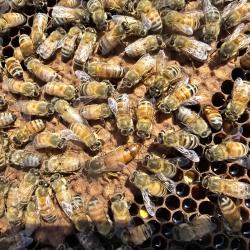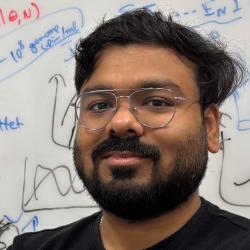Calling All Experimentalists, Designers, Fixers and Tinkerers
Vortex Makerspace and PHYS 499X course offer unique hands-on learning experiences for physics students.
Two of the best-kept secrets in the University of Maryland’s Department of Physics are its Vortex Makerspace and a small class held in the makerspace that is dedicated to the practical skills needed for physics experimentation.
Since 2019, Professor Daniel Lathrop has taught a unique 400-level laboratory course in the Vortex Makerspace (formerly the Physics Welding Shop), which is tucked behind the John S. Toll Physics Building. Designed to teach students hands-on ways to bring their ideas to life, the class touches on topics such as carpentry, circuitry and 3D printing. Lathrop guides the students as they design, plan, build and demo their creations inspired by the semester’s physics lecture topics. But it’s not all about a student’s ability to build from scratch, Lathrop said.
“One thing I really wanted to accomplish with this class was to expose students to skills that they wouldn’t usually come across in their conventional classroom studies,” Lathrop explained. “That not only includes how to make things with their hands but also how to develop soft skills like leadership, budgeting, communication and teamwork—all qualities that are needed in real-life careers in physics.”
To simulate the kinds of situations, goals and challenges that physics experimentalists often encounter, Lathrop wove together 12 weeks of interactive lectures, field trips, training sessions and demonstrations. As his unique lesson plans for the class quickly spread by word of mouth, physics majors eager for a more hands-on learning experience registered for the class.

One of those students, Alexandra Pick-Aluas (B.S. ’22, physics), first heard glowing reviews about Lathrop’s class from two friends and was intrigued by the prospect of a lab elective that could give her a sneak peek into the professional future she hoped to pursue. She realized quickly that the class was unlike any she’d ever taken.
“We were given an introduction to welding, which was obviously something I never tried before,” Pick-Aluas explained. “I learned how to weld pieces of metal together and got to see the difference in outcomes for the different metals I used. For example, aluminum is really easy to melt and that’s one reason why it’s a notoriously difficult metal to weld. It’s one thing to read about it, but it’s a much more enlightening experience to actually see it in action in front of me."
Welding was just one skill Pick-Aluas developed during the class. For their final project, Pick-Aluas and her group members built a superconducting loop—an infinitely flowing electric current with no power source—with materials like scrap metal, a bicycle wheel spoke and superconducting tape. Guided by Lathrop, they designed a suitable prototype within a limited budget, ordered their required materials from specialized vendors, constructed their design and wrote a manual explaining how their project functioned.
“Even though our project didn’t exactly work the way we originally wanted it to, the entire process it took to make the superconducting loop is something I’ll always remember,” Pick-Aluas said. “Professor Lathrop says that in reality, failures and setbacks should be expected before making progress.”
She hopes that more physics majors take PHYS 499X before they graduate. For Pick-Aluas, who is now assisting Lathrop in his lab as she prepares for graduate school, the expertise she gained from the course helped shape her own career goals.
“At first, I was a little intimidated, but the class made me feel a lot more comfortable with these skills. Potentially applying them on the job is a little less daunting to me now,” Pick-Alaus explained. “PHYS 499X is a really good overview of what you can expect in a real-life physics-related profession, whether it’s in academia or in industry.”
Beyond the class, physics majors can also use the Vortex Makerspace—which is housed within the same single-room building as PHYS 499X—for all their experimentalist aspirations. Thanks to key efforts from UMD Physics Director of Education Donna Hammer, Vortex provides a dedicated time and place for students to work on meaningful projects of their own. Equipped with saws, welders, wires, wrenches and other knickknacks ready for students to use, the makerspace also encourages students to walk in and chat with Vortex’s ‘shop managers’ if they need additional guidance, resources or someone to simply bounce ideas off of.
“We’re open four afternoons a week to anyone during the semester—no experience or background necessary,” said Jake Lyon, a senior physics major and vice president of the Vortex Makerspace. “Vortex frequently holds training sessions and workshops for a variety of topics, like intro into basic coding or circuitry.”

Lyon became involved with the makerspace as a sophomore. Over the next few years, he attended a variety of training sessions and eventually developed an arsenal of handy skills from 3D printing to soldering. Then he tested this newly acquired knowledge, applying it to the projects he took on at the makerspace, including his personal favorite, fixing a broken megaphone. He believes taking the megaphone apart, figuring out how it worked and diagnosing what went wrong was an experience that will stay with him long after he graduates.
“The Vortex is a fantastic place to learn and get comfortable with the basic parts of fabrication with the right equipment while also getting to know the physics makers community,” Lyon said. “We facilitate learning but try to encourage teamwork and communication with everyone as well.”
In addition to the activities held during the semester, the Vortex Makerspace also offers a series of summer programs, including the Physics Makers Camp for high school students looking to get a head start on creative thinking and design, run by Outreach Coordinator Angel Torres. And although Vortex is run by physics undergraduates, Lyon said the organization welcomes anyone who wants to bring a project to life.
“We have a good lineup of ideas for workshops in the spring semester, so anyone—including non-physics majors—looking to acquire a new handy skill or two is welcome to stop by,” Lyon said. “Just bring an idea and we’ll bring the tools.”







